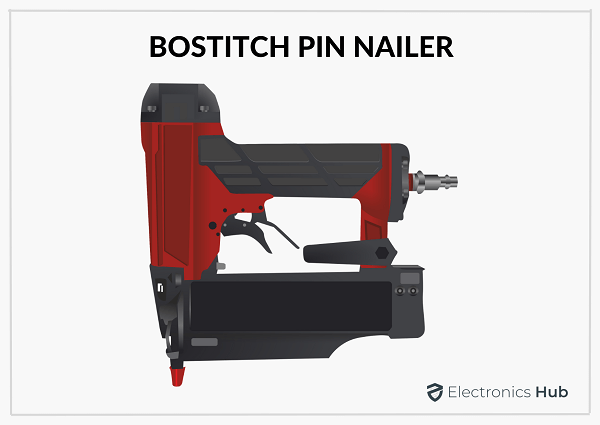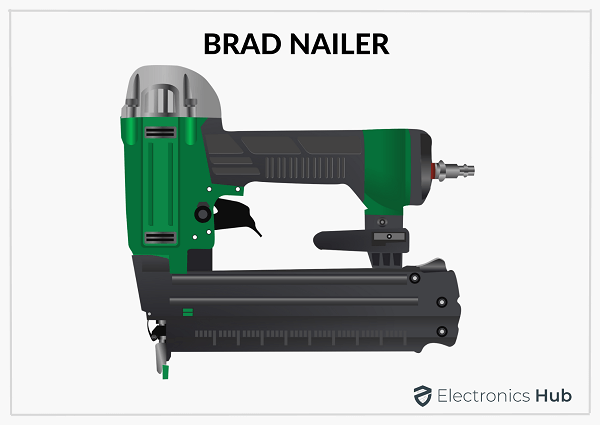In carpentry work, the worker has to maintain a lot of precision. This woodworking includes shaping, sizing, and fitting the wooden material. To maintain the accuracy in this work various tools are present in the market to assist the DIY artist in you. One such tool is the nail gun. It has successfully replaced the conventional hammer and nail.
A nail gun or a nailer gun is a small power tool. This handheld tool is used to hammer nails into the wood to join two parts. They save time and result in a better finishing of the worked surface. The nail gun is available in two different types: pin nailer and brad nailer gun. Both serve the same application of driving nails into the wooden surface.
So how do they differ from each other? To understand the difference, we will have to first understand each type of nail gun. This article will help you understand everything related to nail gun types.
Outline
TogglePin Nailer
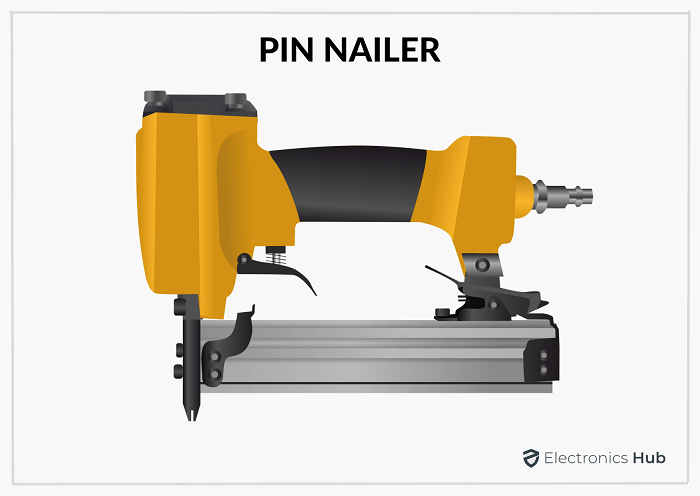
The pin nailer has a nail rack into which nails are stored. The number of nails stored per inch of the rack is called the gauge of nails. The pin nailer usually uses 23-gauge nails. These nails are headless and hence blend with the wooden surface as if it is not even there.
Now that we have an idea about what a pin nailer is, let us discuss the pros and cons of a pin nailer.
Pros:
- The pin nailer does not create any damage to the wooden surface
- The nail used is headless and blends with the surface without being noticeable
- The nailer offers easy penetration to the wooden surface
- The nail holes created by a pin nailer are small and can be easily covered
Cons:
- The pin nailers are not suitable for hard surfaces
- The pins have a lower strength in holding the material
- Since it uses headless nails, the process of pulling the nail out becomes hectic
Where Can We Use A Pin Nailer?
As discussed earlier, the nails used in the pin nailer have a low holding strength. The nails are small in size and are hardly visible to the eyes. Hence the pin nailer can be used where smaller wooden pieces need to be joined. The small size of the nail creates no creeping of the wood and helps in maintaining the strength of the wooden piece.
The pin nails are commonly used with wood glues to increase the strength of the joints. The pin nailer does not leave any noticeable holes after nailing the surface. This helps in preserving the aesthetics of the surface and requires less retouching.
Steps To Use A Pin Nailer
Pin nailer is a type of nail gun. It involves firing the nails onto the wooden surface to mimic the hammering effect of a hammer. Hence certain steps are needed to be followed while using a pin nailer:
- Do Proper Safety Checks: This step involves wearing proper glasses, aprons, and earplugs. If a pneumatic system is used, checking the system pressure becomes mandatory too.
- Secure the Surface to be Nailed: Proper mounting of the surface keeps it locked in position while using a pin nailer.
- Position and Fire: By keeping the center of the gun in line with the hole center, the nail will be accurately placed. After positioning the gun, press the gun triggers to shoot the nail into the surface.
- Inspect: Check for the proper placement of the nail. Also, check for any debris or any irregularities near the pinned surface.
Best Pin Nailer Options
The market is flooded with pin nailers to choose from but we have mentioned our favorites below. Their specifications are also provided to help you understand them closely.
1. Bostitch Pin Nailer
Bostitch is a familiar name in the power tool brands. Its products are known for being reliable with excellent durability.
The HP118K Pin Nailer from Bostitch is an ideal option. It can accommodate the standard 23-gauge pins of length ½ to 1 3/16-inches. It has a lightweight construction that makes it easy to use. Since it is powered by a pneumatic system, it has a ¼-inch inlet port to let the compressed air in. It also has a 7-year warranty that instills confidence in the user.
2. Makita Pin Nailer
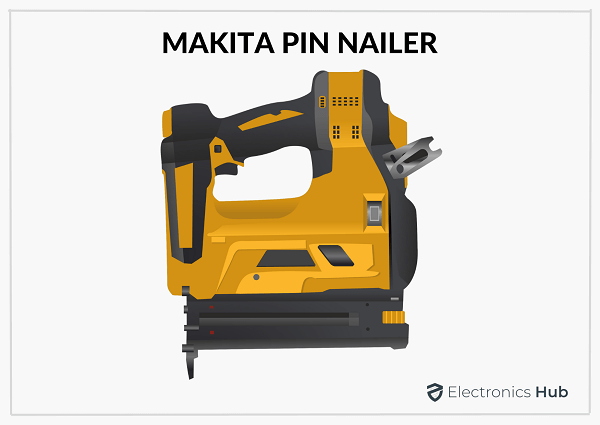
The AF353 Pin Nailer from Makita is a good alternative too. It supports a wider length of 23-gauge nails for the pin rack. Nails of length from ⅝-inch to 1 ⅜-inch easily fit the nailer magazine. The magazine has a high capacity of 120+ nails to ensure a continuous supply of nails. Being a lightweight nail gun it can be easily positioned and used.
Brad Nailer
The working of a brad nailer is not so different from a pin nailer. They can also be powered with removable batteries or via a pneumatic circuit. What makes them different from the pin nails is the type of nails they use.
The brad nailers use small nails with a finishing. These nails are a little bigger than the 23-inch gauge nails. Their size is usually 16-gauge or 18-gauge. Their size makes them ideal for various applications that need a finished nail.
Having explained about brad nailers, we can move on to the pros and cons of these nailers.
Pros:
- Brad nailers are lightweight and hence can be used anywhere
- No clamping is needed while using the brad nailers
- Since the nails are of bigger gauges, it helps in adding strength to the nailed joint
- Nails hammered by brad nailer can be easily removed due to their flat head design
Cons:
- It is not suitable for delicate surfaces as its bigger nails may develop cracks
- The brad nailers leave a noticeable hole on the surface
- It cannot be used on thick wooden pieces
Where Can We Use A Brad Nailer?
The brad nailer uses stronger nails. This makes it suitable for joining two pieces with added strength. It also finds its use in fitting decorative trims, windows, and boards. Brad nailers are most commonly used on softwood materials since they easily penetrate the surface without cracking it. They do not need wood glue to add strength to the joined pieces. It instead offers a better holding strength than pin nailers.
Steps To Use A Brad Nailer
Using a brad nailer is not different from a pin nailer. The following steps will guide you through the necessary steps to use a brad nailer.
- Safety Checkups: Using proper safety glasses, aprons, and earplugs help in minimizing any hazardous situation.
- Tool Adjustments: If the brad nailer is pneumatic power, proper pressure must be set to achieve good penetration. The pressure must be kept below the allowable value.
- Positioning: Even with a slighter deviation, the nail will bend. Hence proper positioning of the brad nailers and the surface is important. Setting the proper depth is also done to reach the required depth.
- Fire and Inspection: The nail can be shot by pressing the trigger of the brad nailer. After successful penetration, proper inspection is done to check for any damage or irregularities.
Best Brad Nailer Options
Many brands have developed their brad nailer by keeping consumer demand in mind. We have selected a few options for you along with their specifications.
1. Ryobi Brad Nailers
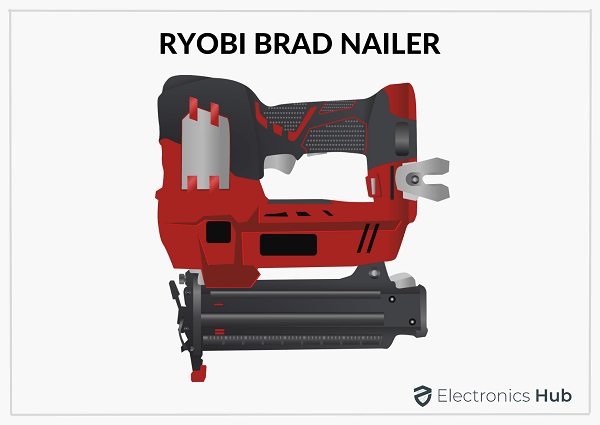
The P320 model in the Ryobi Brad Nailer series is one of the most affordable options available in the market. This nailer is powered with a battery and supports the standard 18-gauge nails. It can fit nails of length ½-inch to 1 3/16-inch into the nail cartridge rack. With the depth adjustment option, this brad nailer offers control over the nail depth.
2. Metabo Brad Nailers
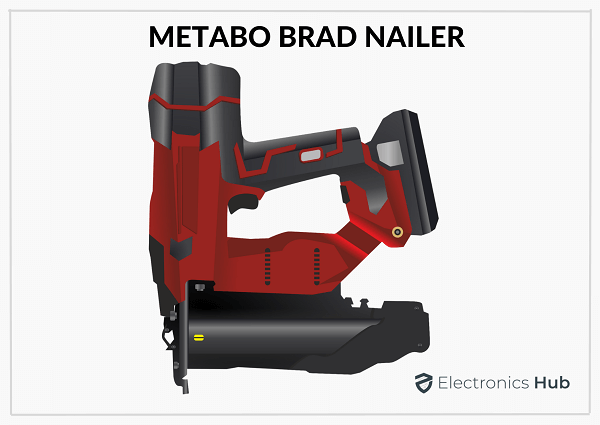
The NT50AE2 model from Metabo offers the best value against its price tag. This model uses the standard 18-gauge nails. The length of the nails acceptable for the nail rack is from ⅝-inch to over 2-inch. Being lightweight it can be used in any orientation with a single hand. It has good durability and a 5-year warranty that makes it a reliable brad nailer.
Comparison Chart For Pin and Brad Nailers
| Parameter | Pin Nailer | Brad Nailer |
| Nailhead type | The pin nailer uses headless nails | The brad nailer uses nails that have flat heads |
| Gauge range | The nails used are of the 23-gauge size | The nails used are of the 18-gauge size |
| Strength | The holding strength offered is lower. It can be improved by using glue. | It offers a very good holding strength |
| Finishing work | The pin nailers create smaller, non-noticeable holes. Hence surface finishing or coating is not needed. | The brad nailers leave a noticeable hole near the penetration area. Hence the hole needs to be filled. |
| Versatility | Pin nailers can only be used for delicate applications and hence their use is limited. | Brad nailers can be used for delicate as well as other types of projects. |
| Applications | It is used for thin and soft materials | It can be used for soft as well as hard materials |
Pin Nailer vs Brad Nailer – FAQs
Ans: A pin nailer is often used for delicate or intricate woodworking projects, such as attaching small moldings, trim pieces, or veneers. It is suitable for situations where a discreet and minimalistic fastening solution is required.
Ans: A brad nailer is commonly used for slightly larger woodworking projects. It is suitable for attaching larger trim pieces, crown molding, and other decorative elements. Brad nailers provide more holding power compared to pin nailers.
Ans: While they have some overlap in applications, pin nailers and brad nailers are not entirely interchangeable. Pin nailers are best for extremely delicate work, while brad nailers provide more holding strength. The choice depends on the specific needs of the project.
Ans: Pin nailers are limited by the size of the fasteners they use. Due to their smaller size, they may not provide enough holding power for larger or heavier pieces of wood. It’s crucial to consider the project requirements and choose the appropriate tool accordingly.
Ans: In general, pin nailers and brad nailers can be used with the same type of air compressor. However, it’s essential to check the specific requirements of the nailer and ensure that the compressor can provide the necessary pressure and volume of air.
Conclusion
The pin nailer and brads nailer offers the helping hand for any DIY or woodworking project. Both are subtypes of nail guns and work on the same principle. Some factors make them different from each other. These factors help in choosing the right type as per the application. Our guide has explained both types of nailers along with their important details. It will help you understand the nail guns more deeply and will assist you in your next purchase.

